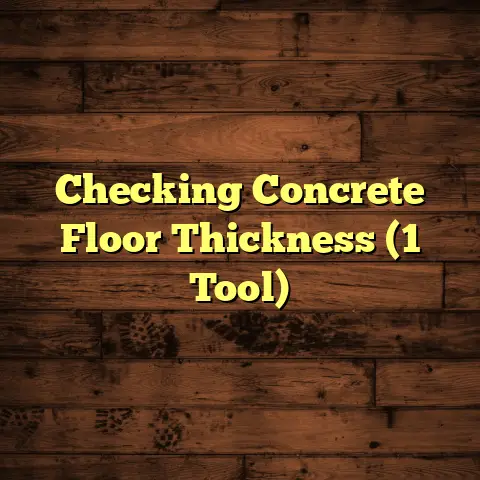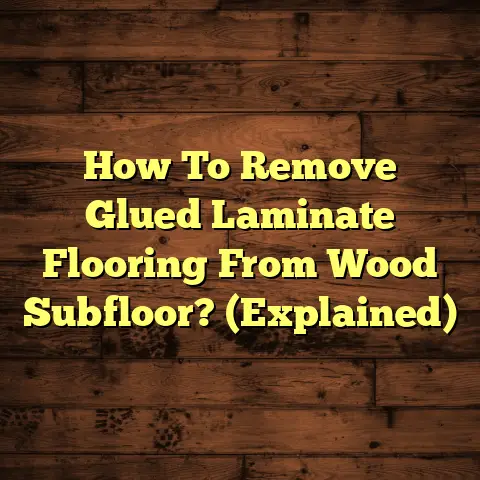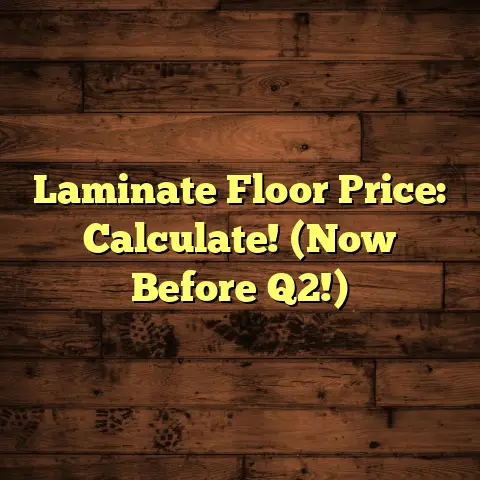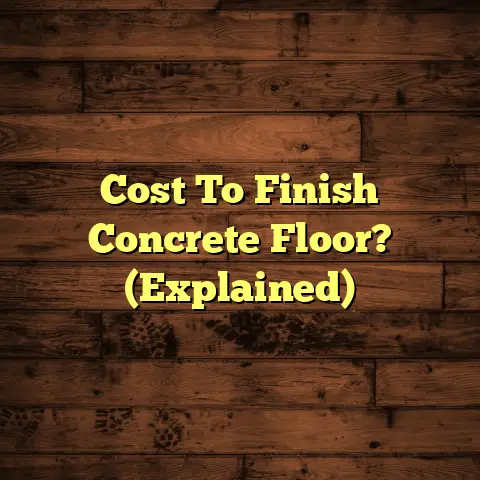Improve Garage Floor Look (6 Cheap Fixes NOW!)
Spring is in the air, and summer’s right around the corner!
That means it’s time to shake off the winter blues and tackle those home improvement projects you’ve been putting off.
And let’s be honest, the garage is often the forgotten child of the house, isn’t it?
It’s usually just a place to park cars, maybe store some tools, and generally accumulate clutter.
But your garage can be so much more! It could be a workshop, a home gym, or even a cool hangout spot.
The key to unlocking that potential? A garage that’s not only functional but also visually appealing.
And guess what? You don’t need to break the bank to achieve a garage floor that looks fantastic.
I’m going to share six cheap fixes you can do NOW to transform your garage floor from drab to fab!
Section 1: The Importance of Garage Floor Aesthetics
Okay, let’s talk about why a good-looking garage floor actually matters. It’s not just about appearances!
Think about it: a clean, well-maintained floor instantly makes the whole garage feel more organized.
You’re more likely to keep things tidy when you’re not staring at a cracked, stained mess.
Plus, a good floor can improve the overall functionality of the space.
Imagine trying to work on a project with a bumpy, uneven surface. Not fun, right?
A smooth, even floor makes it easier to move around, work on projects, and even clean up spills.
But don’t just take my word for it. According to a recent survey by the National Association of Home Builders, homeowners are increasingly prioritizing garage upgrades.
They found that a finished garage, including the floor, can add significant value to your home.
And let’s be real, nobody wants to see a garage floor that’s covered in oil stains, cracks, or peeling paint.
These issues not only look bad but can also pose safety hazards. Cracks can trip you up, and oil stains can be slippery.
Common Garage Floor Issues:
- Stains (oil, grease, chemicals)
- Cracks (small hairline cracks to larger, deeper ones)
- Dust and debris
- Uneven surfaces
- Peeling or chipping paint/coatings
- Moisture problems
Addressing these issues is key to creating a garage you’re actually happy to spend time in.
And the best part? You don’t need to spend a fortune!
Section 2: Fix #1 – Concrete Resurfacing
So, you’ve got a garage floor that’s seen better days? Concrete resurfacing might be just what you need.
Essentially, concrete resurfacing involves applying a thin layer of new concrete or a cement-based overlay to your existing floor.
This covers up imperfections like cracks, stains, and minor damage, giving you a smooth, fresh surface to work with.
I’ve personally used concrete resurfacing on several projects, and it’s amazing how it can completely transform a space.
Here’s a step-by-step guide:
-
Preparation: This is the most important step! Thoroughly clean the floor, removing any dirt, oil, or debris. You might need to use a degreaser and a pressure washer for this.
-
Repair Cracks: Fill any cracks with a concrete patching compound. Let it dry completely according to the manufacturer’s instructions.
-
Etch the Concrete: Use a concrete etcher to open up the pores of the concrete. This helps the resurfacing compound bond properly.
-
Mix the Resurfacing Compound: Follow the manufacturer’s instructions carefully. Consistency is key!
-
Apply the Compound: Use a trowel or squeegee to apply the resurfacing compound evenly over the floor. Work in small sections.
-
Finish: Depending on the compound you’re using, you might need to apply a second coat or add a texture.
-
Cure: Allow the resurfaced floor to cure completely before driving on it or using it heavily. This could take several days.
Materials and Tools You’ll Need:
- Concrete resurfacing compound
- Concrete patching compound
- Concrete etcher
- Pressure washer
- Degreaser
- Trowel or squeegee
- Mixing bucket
- Drill with mixing attachment
- Safety glasses and gloves
Tips for Success:
- Choose a resurfacing compound specifically designed for garage floors.
- Read and follow the manufacturer’s instructions carefully.
- Work in small sections to ensure even coverage.
- Don’t rush the curing process.
- Consider adding a sealant for extra protection.
Section 3: Fix #2 – Epoxy Coating
Want a garage floor that’s not only beautiful but also super durable and easy to clean? Epoxy coating is the way to go!
Epoxy is a thermosetting resin that creates a hard, protective layer when applied to concrete.
It’s resistant to chemicals, stains, and abrasions, making it perfect for a garage environment.
Plus, it comes in a wide variety of colors and finishes, so you can customize the look of your garage.
Here’s how to apply an epoxy coating:
-
Preparation: Just like with resurfacing, preparation is key. Clean the floor thoroughly, repair any cracks, and etch the concrete.
-
Prime the Floor: Apply a concrete primer to help the epoxy bond properly. This is an important step that many people skip, but it really makes a difference in the long run.
-
Mix the Epoxy: Epoxy typically comes in two parts: a resin and a hardener. Mix them together according to the manufacturer’s instructions. Be precise with your measurements!
-
Apply the Epoxy: Use a roller or brush to apply the epoxy evenly over the floor. Work in small sections and try to maintain a wet edge.
-
Add Flakes (Optional): If you want to add decorative flakes or chips, sprinkle them over the wet epoxy.
-
Apply a Topcoat (Optional): A clear topcoat can add extra protection and durability.
-
Cure: Allow the epoxy to cure completely before driving on it or using it heavily. This could take several days.
Potential Pitfalls to Avoid:
- Moisture: Epoxy doesn’t bond well to damp concrete. Make sure your floor is completely dry before applying it.
- Temperature: Epoxy needs to be applied in moderate temperatures. Check the manufacturer’s instructions for the ideal temperature range.
- Mixing Errors: Incorrect mixing can lead to a sticky, uneven finish. Follow the instructions carefully!
- Bubbles: Air bubbles can form in the epoxy. Use a spiked roller to remove them.
Pro Tip: Consider renting a floor grinder to properly prepare the concrete. This will create a much better surface for the epoxy to bond to, resulting in a longer-lasting finish.
Section 4: Fix #3 – Floor Paint
Looking for a quick and easy way to refresh your garage floor without breaking the bank? Floor paint might be the perfect solution.
While not as durable as epoxy, specialized floor paint is still a great option for improving the appearance of your garage floor.
It’s relatively inexpensive and easy to apply, making it a popular choice for DIYers.
Types of Floor Paint:
- Oil-Based: Durable and resistant to chemicals, but takes longer to dry and can be more difficult to clean up.
- Latex: Easier to apply and clean up than oil-based paint, but not as durable.
- Specialized Garage Floor Paints: Formulated specifically for garage floors, these paints offer a good balance of durability and ease of use.
Here’s how to paint your garage floor:
-
Preparation: You know the drill! Clean the floor thoroughly, repair any cracks, and etch the concrete.
-
Prime the Floor: Apply a concrete primer to help the paint adhere properly.
-
Paint the Floor: Use a roller or brush to apply the paint evenly over the floor. Apply two coats for best results.
-
Allow to Dry: Let the paint dry completely before walking on it or using the garage. This could take 24-48 hours.
Tips for Achieving a Smooth, Even Finish:
- Use a high-quality roller and brush.
- Apply thin, even coats of paint.
- Avoid painting in direct sunlight or extreme temperatures.
- Consider adding a non-slip additive to the paint for extra safety.
Important Note: While floor paint is a cheaper option than epoxy, it’s also less durable. You’ll likely need to reapply it every few years.
Section 5: Fix #4 – Interlocking Floor Tiles
Want a garage floor that’s both functional and stylish? Interlocking floor tiles are a fantastic option.
These tiles are easy to install, require no special tools, and come in a variety of materials and colors.
Plus, they’re durable, easy to clean, and can withstand heavy traffic.
Types of Interlocking Floor Tiles:
- Rubber: Durable, slip-resistant, and comfortable to walk on. Ideal for garages used as gyms or workshops.
- Vinyl: Affordable, easy to clean, and available in a wide range of colors and patterns.
- Plastic: Lightweight, durable, and resistant to chemicals and stains.
Installation Instructions:
-
Measure the Garage: Measure the length and width of your garage to determine how many tiles you’ll need.
-
Clean the Floor: Sweep or vacuum the floor to remove any dirt or debris.
-
Start in a Corner: Begin laying the tiles in one corner of the garage.
-
Interlock the Tiles: Simply snap the tiles together.
-
Cut Tiles (If Necessary): If you need to cut tiles to fit around walls or obstacles, use a utility knife or jigsaw.
-
Finish the Edges: Use edge pieces to create a clean, finished look along the walls.
Benefits of Interlocking Floor Tiles:
- Easy to install
- Durable and long-lasting
- Easy to clean
- Comfortable to walk on
- Visually appealing
Downsides to Interlocking Floor Tiles:
- Can be more expensive than paint
- Water can seep underneath the tiles if not properly sealed
Section 6: Fix #5 – DIY Floor Mats and Rugs
Okay, maybe you’re not ready for a full-blown floor makeover. That’s totally fine!
You can still significantly improve the look of your garage floor with some strategically placed mats and rugs.
This is a super affordable and easy way to add some personality and protection to your garage.
Ideas for DIY Floor Mats:
- Old Carpets: Cut old carpets to size and bind the edges to prevent fraying.
- Rubber Mats: Purchase rubber mats from a hardware store and customize them with paint or stencils.
- Pallet Wood: Disassemble pallets and use the wood to create a rustic-looking floor mat.
Tips for Choosing Mats and Rugs:
- Durability: Choose mats and rugs that are durable and can withstand heavy traffic.
- Easy to Clean: Look for mats and rugs that are easy to clean and resistant to stains.
- Slip-Resistance: Make sure the mats and rugs have a non-slip backing to prevent accidents.
- Size and Placement: Choose mats and rugs that are the right size for your garage and place them in high-traffic areas.
Creative Ways to Use Mats and Rugs:
- Create a Workspace: Place a mat under your workbench to protect the floor and provide a comfortable surface to stand on.
- Define Parking Spaces: Use mats to mark parking spaces and prevent oil drips from staining the floor.
- Add Color and Style: Choose mats and rugs that complement the overall decor of your garage.
Section 7: Fix #6 – Decorative Concrete Stamping
Ready to take your garage floor to the next level? Decorative concrete stamping is a fantastic option that offers a high-end look without the high-end price tag.
Concrete stamping involves imprinting patterns and textures into freshly poured or resurfaced concrete.
This creates a beautiful, customized look that can mimic the appearance of brick, stone, or tile.
The Stamping Process:
-
Prepare the Concrete: Pour or resurface the concrete as described in Fix #1.
-
Apply Color Hardener (Optional): Apply a color hardener to the concrete to add color and durability.
-
Apply Release Agent: Apply a release agent to the concrete to prevent the stamps from sticking.
-
Stamp the Concrete: Use concrete stamps to imprint the desired pattern into the concrete. Work in small sections and overlap the stamps slightly.
-
Cure the Concrete: Allow the concrete to cure completely before sealing it.
-
Seal the Concrete: Apply a concrete sealer to protect the stamped surface and enhance the color.
Designs and Patterns:
- Brick: Mimics the look of traditional brick paving.
- Stone: Creates a natural stone look with varying textures and patterns.
- Tile: Replicates the appearance of ceramic or porcelain tile.
- Wood Plank: Offers a rustic wood look with grain patterns and textures.
Tools and Materials:
- Concrete stamps
- Color hardener (optional)
- Release agent
- Concrete sealer
- Trowel
- Tamper
Important Considerations:
- Concrete stamping requires some skill and experience. If you’re not comfortable working with concrete, consider hiring a professional.
- The weather can affect the stamping process. Avoid stamping concrete in extreme temperatures or during rain.
Conclusion
So, there you have it! Six cheap and effective ways to improve the look of your garage floor NOW.
From simple fixes like floor paint and mats to more involved projects like concrete resurfacing and epoxy coating, there’s a solution for every budget and skill level.
Don’t let your garage be the forgotten space in your home. With a little effort and creativity, you can transform it into a functional and visually appealing area that you’re proud of.
And with spring and summer just around the corner, now’s the perfect time to tackle those home improvement projects and create a space you’ll love.
So, what are you waiting for? Get started today and create the garage of your dreams!





